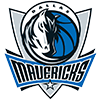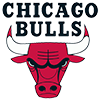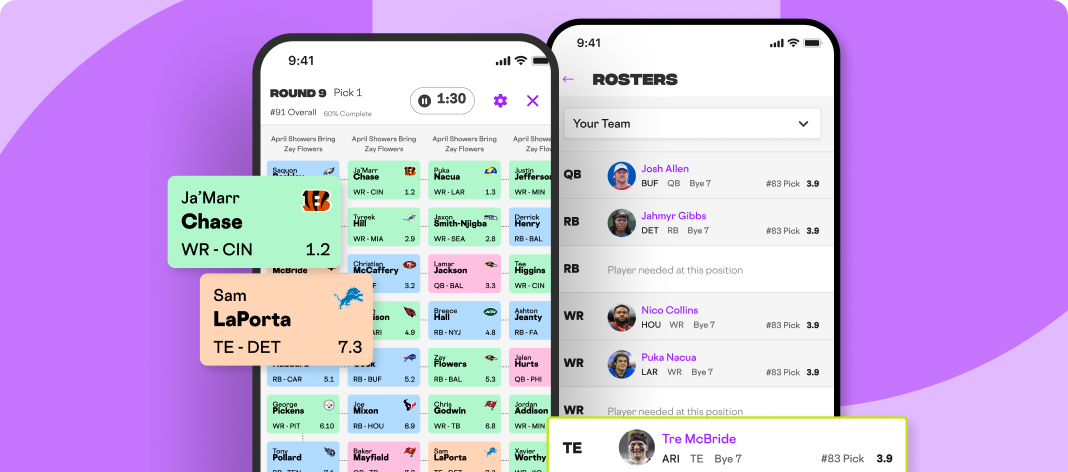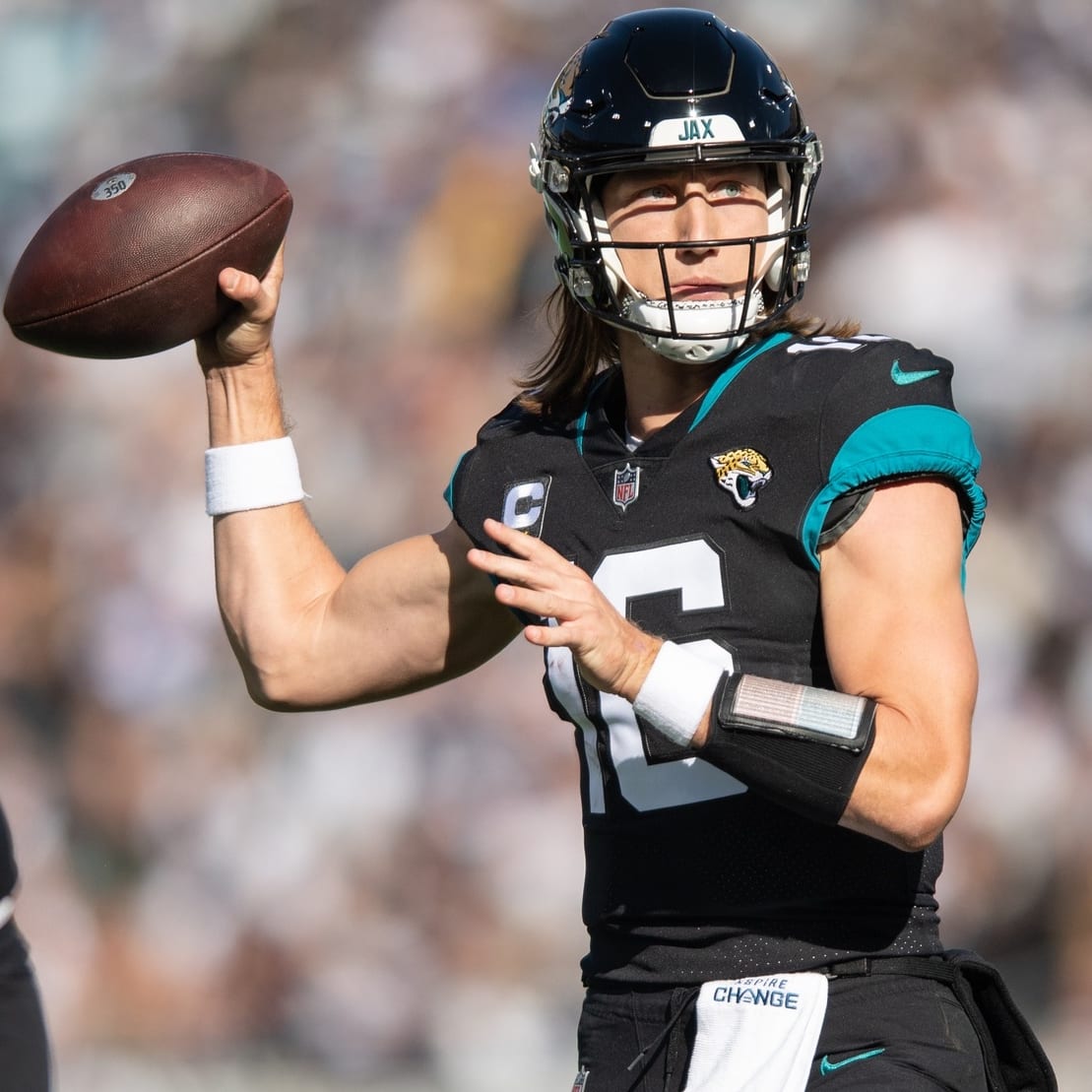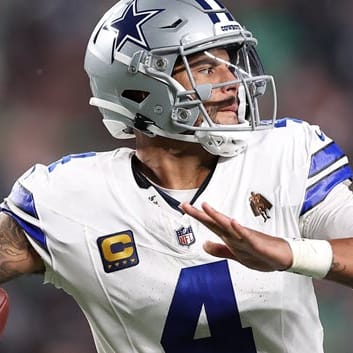With pro days concluding the final pre-draft board has become as clear as it's going to get, and this article tries to make some order out of a player pool that has resisted consensus to this point.
The players are grouped into tiers, and two or more players playing the same position within a tier will have their blurbs grouped together. There are 12 tiers, and the number of players in each tier is parenthetically indicated after the tier header.
TIER 1 (1)
Ashton Jeanty, RB, Boise State (5-9, 211)
Ashton Jeanty is the 1.01 and to me he's a better prospect than even the likes of Bijan Robinson or Jahmyr Gibbs. Prospect outcomes relative to prospect profiles rarely go on a 1:1 exchange rate, but Jeanty's entire range of outcomes projects to be near the top of the running back position.
TIER 2 (1)
Omarion Hampton, RB, North Carolina (6-0, 221)
Omarion Hampton is not on Jeanty's level but he still might produce similar fantasy point totals, if only by volume. Hampton is built to carry an offense, both in the sense of volume and per-play efficiency, and a three-down role should occur early or immediately in his career.
TIER 3 (6)
Tetairoa McMillan, WR, Arizona (6-4, 219)
Jayden Higgins, WR, Iowa State (6-4, 214)
Quinshon Judkins, RB, Ohio State (6-0, 221)
TreVeyon Henderson, RB, Ohio State (5-10, 202)
Tyler Warren, TE, Penn State (6-6, 256)
Colston Loveland, TE, Michigan (6-6, 246)
At receiver Tetairoa McMillan won't confuse anyone for Ja'Marr Chase or arguably even DeVonta Smith, but McMillan should be closer to a WR1 in the NFL than a WR2. The lag in his profile would probably be in the catch rate, but McMillan's ability to draw downfield targets at a high rate is a better measure of how he affects the game. Defenses need to give McMillan space, but if they give him space he's just good enough to attack the cushion that it should leave coverage in a consistently difficult spot. This is a case where you can probably expect YPT to offset any deficiency in catch count. Jayden Higgins warrants a top-20 selection in my opinion, let alone one in the first round. Even something like a 4.55-second 40-yard dash would have been a good time for a player with Higgins' skill set, so going sub-4.5 was pretty much a dream scenario for him.
Quinshon Judkins likely has more workhorse upside than TreVeyon Henderson, though Henderson likely has more pass-catching upside and big-play ability. Judkins is likely a competent pass catcher in his own right, though, and his 4.48-second 40 was a lot closer than what was expected to Henderson's 4.43.
Tyler Warren and Colston Loveland are both uniquely good tight end prospects, though they're slightly different. Warren's versatility stands out compared to Loveland but Loveland projects to be a 100-catch candidate at tight end in his own right. Guessing which is better might be a waste of time.
TIER 4 (4)
Tre Harris, WR, Mississippi (6-2, 205)
Luther Burden, WR, Missouri (6-0, 206)
Matthew Golden, WR, Texas (5-11, 191)
RJ Harvey, RB, UCF (5-8, 205)
At receiver Tre Harris offers more production and standout tape, while Luther Burden provides standout production in his own right, and with better athletic testing than Harris. Both players project as potential WR1s in the NFL, though in the meantime the concern with Burden would be his downfield route-running acumen and in Harris' case it's fair to worry that his otherwise elite production was partially owed to the system he played in. Matthew Golden didn't put quite as much on tape or the box score but his 40 time was exceptional for a player who otherwise looks fundamentally polished, and to be fair to Golden, he always played in crowded pass-catcher groups at Houston and Texas.
I wanted to rank R.J. Harvey higher than this – all the way ahead of TreVeyon Henderson in Tier 3 – but Harvey's market is so much lower than Henderson's at the moment that I have to acknowledge the probability that Henderson has superior draft capital, and potentially by a lot. With that said, I think Harvey is awesome and should be one of the league's most explosive players from scrimmage early in his career.
TIER 5 (7)
Jalen Royals, WR, Utah State (6-0, 205)
Jaylin Noel, WR, Iowa State (5-10, 194)
Emeka Egbuka, WR, Ohio State (6-1, 202)
Cameron Skattebo, RB, Arizona State (5-10, 219)
Cam Ward, QB, Miami (FL) (6-2, 219)
Mason Taylor, TE, LSU (6-5, 251)
Harold Fannin, TE, Bowling Green (6-3, 241)
Jalen Royals in theory offers a lower floor but higher ceiling at wide receiver than Emeka Egbuka, who ostensibly offers reliability at the potential cost of upside. I'm concerned that Egbuka is largely just a poor man's Jaxon Smith-Njigba, though someone could reasonably suspect that would still equal a valuable fantasy wideout. In Royals' case it's tough to evaluate his relatively short period of productivity at Utah State, but his excellent per-game production the last two years pairs with his plus athletic testing to produce a solid Day 2 profile. Jaylin Noel kept pace with Higgins at Iowa State, and he has the wheels to make up for lack of reach.
Cameron Skattebo has a clear three-down skill set and workhorse mentality, but his ~4.7 speed is arguably a problem. He's probably more Round 3-to-4 than Round 2 at this point.
Cam Ward probably doesn't offer any plus tools but his grasp of the game and ability to sense opportunity as a downfield passer could give him enough playmaking ability to be an above-average quarterback in the NFL. What I don't see as easily is a scenario where Ward produces well in a high-volume role. For that reason I see him more as a Brock Purdy tier of quarterback rather than one that should throw 600-plus passes per year.
Mason Taylor might not be immediately productive as a receiver and might not be one of the league's very best at tight end during his peak, but he should be at least an average starting NFL tight end for most of the upcoming decade. This isn't meant to completely play down his upside – Taylor earned rare praise from LSU coaches and his otherwise modest pass-catching production might be attributable to LSU's absurd wideout talent. Harold Fannin has an ambiguous but potentially sufficient athleticism grade complicating the projection of an excellent pass-catching skill set. Fannin might lack inline potential so it's important that he's convincing to NFL teams as a pass-catching specialist so they don't care about whatever blocking limitations he might have. If Fannin hits then his pass-catching upside could prove uncommon.
TIER 6 (8)
Jack Bech, WR, TCU (6-1, 214)
Elic Ayomanor, WR, Stanford (6-2, 206)
Travis Hunter, WR/CB, Colorado (6-0, 188)
Tahj Brooks, RB, Texas Tech (5-9, 214)
Damien Martinez, RB, Miami (FL) (6-0, 217)
Bhayshul Tuten, RB, Virginia Tech (5-9, 206)
Jaxson Dart, QB, Mississippi (6-2, 223)
Shedeur Sanders, QB, Colorado (6-2, 212)
Jack Bech once matched stride (in terms of production) with Malik Nabers and Brian Thomas at LSU, so he can only be so bad, and his seemingly modest production at TCU can probably be rationalized by the deep and experienced target competition on TCU, including fellow 2025 prospects Savion Williams and JP Richardson. Elic Ayomanor might need some time to refine after playing in a primitive Stanford offense, but the production, athleticism and size are all good.
Travis Hunter is very likely the top wide receiver in this class, but my concern with him as a fantasy asset is that he's the best cornerback in this class and most others also. Perhaps Hunter will play more snaps per season than any player since Jim Thorpe or whatever, but I still think cornerback will be the likely prioritized position of the two and even an outrageous figure like 90 snaps per game isn't enough to make a predictable fantasy impact when 60 of those snaps will likely be on defense. Hunter can produce at a blistering per-snap pace on offense, but if he's playing 20 or 30 snaps then it probably won't matter.
Tahj Brooks isn't explosive but his well-rounded game is intriguing and he has the kind of natural anchor that wears on a defense. Damien Martinez can likely play at at least 10 pounds heavier than the 217 pounds he weighed at the combine, and he provided unusual big-play ability at that build at both Oregon State and Miami (FL). Bhayshul Tuten is extremely fast and has an extensive history of demonstrating unique big-play ability, but he might struggle to ever be more than a flex-type play given his limitations otherwise, including ball security and receiving ability.
While they have various concerns and apparent limitations in their games, Jaxson Dart and Shedeur Sanders are locked into the first round, especially Sanders. Dart likely offers more fantasy upside as the superior runner of the two. I would try to trade either one before their rookie years start, because I'm skeptical that either will stick as a starter. I mostly list them this high to acknowledge their market standing, which gives them trade value for now.
TIER 7 (10)
Isaiah Bond, WR, Texas (5-11, 180)
Kyle Williams, WR, Washington State (5-11, 190)
Nick Nash, WR, San Jose State (6-3, 203)
Tory Horton, WR, Colorado State (6-3, 196)
Devin Neal, RB, Kansas (5-11, 213)
Jaydon Blue, RB, Texas (5-9, 196)
Trevor Etienne, RB, Georgia (5-9, 198)
Woody Marks, RB, USC (5-10, 207)
Gunnar Helm, TE, Texas (6-5, 241)
Oronde Gadsden, TE, Syracuse (6-4, 241)
At receiver Isaiah Bond is fast and has at least rotational ability, though his grades for character might lag in comparison if Bob McGinn's sources are to be believed. Tory Horton probably compares to a lanky speedster like Troy Franklin, while Kyle Williams might be something like Marvin Mims, if a bit heavier and slower with probably worse hands. Nick Nash is likely slot dependent, but he has an uncommon combination of ruggedness and hands that should interest teams.
Devin Neal might slip a bit since he is neither dense nor fast, but his athletic testing was fine and his production at Kansas implies viable ability from scrimmage in the NFL. Trevor Etienne would ideally be something like an off-the-bench space specialist, though in that capacity he could prove good enough to become a regular, if modest contributor. Woody Marks didn't run as fast as I hoped and therefore looks something like a late-career Jerick McKinnon, though that's also to point out potentially uncommon pass-catching usage, which could be enough to offset his deficiencies as a fantasy asset. Jaydon Blue is a lot faster than Marks and offers equal or better pass-catching upside, but ball security and volume upside don't seem favorable for Blue and his stride might be a tad unwieldy.
Gunnar Helm should prove at least an average starting tight end at some point, but he seems well behind Mason Taylor in the draft order and as a fantasy prospect specifically he probably doesn't offer the unique pass-catching upside that Harold Fannin does. As the likely TE5 in this class he should at once have a good career yet also might take a little time to establish himself, so patience is in order even if he starts slow (not that he necessarily will). Oronde Gadsden is a tough one for me to figure out, because he doesn't seem to be taken very seriously as a tight end yet might have enough pass-catching ability to compel some substantial amount of NFL playing time anyway.
TIER 8 (12)
Raheim Sanders, RB, South Carolina (6-0, 217)
Kaleb Johnson, RB, Iowa (6-1, 224)
Ollie Gordon, RB, Oklahoma State (6-1, 226)
D.J. Giddens, RB, Kansas State (6-1, 212)
Montrell Johnson, RB, Florida (5-11, 212)
Dylan Sampson, RB, Tennessee (5-8, 200)
Jarquez Hunter, RB, Auburn (5-9, 204)
Jordan James, RB, Oregon (5-10, 205)
Pat Bryant, WR, Illinois (6-2, 204)
Tai Felton, WR, Maryland (6-1, 183)
Jalen Milroe, QB, Alabama (6-2, 217)
Quinn Ewers, QB, Texas (6-2, 214)
Raheim Sanders lacks ideal anchor but offsets that somewhat with plus speed (4.46 40) and likely above-average receiving ability. Kaleb Johnson definitely has high-quality production and remains a solid prospect, but his combine numbers were not reassuring, at least not in a running back class this competitive. Johnson and Ollie Gordon are basically the same player to me, but the public is much higher on Johnson for some reason. D.J. Giddens has a stance/gait that is almost more appropriate for a receiver, but he arguably has a Jerious Norwood sort of quality. Montrell Johnson seems a lot like Isiah Pacheco, for better or worse – very fast with an aggression that encroaches on recklessness. Dylan Sampson and Jarquez Hunter are largely the same category of player, which is to say fast, skilled pure runners who are smallish and with questionable passing-down projections. Jordan James was super productive at Oregon and flashes some uncommon movement on tape, but his athletic testing (4.55-second 40) was average at best, and he likely has a worse passing-down projection than his former teammate Bucky Irving did.
Even though wideout Pat Bryant lacks speed his fundamentals look smooth and his production was strong at Illinois despite fighting two other NFL players for targets (Isaiah Williams and Casey Washington) in a relatively weak passing game. Tai Felton really broke out statistically after getting more slot looks in 2024, and he has the athleticism to line up outside in the NFL, too.
Jalen Milroe likely lacks the passing ability necessary to stick as a starting quarterback, but his unique rushing ability grants him substantial fantasy upside in the event that he does get snaps. Quinn Ewers is probably just another Chad Henne type or something, though in this weak quarterback class I don't think he can be counted out entirely.
TIER 9 (14)
Elijhah Badger, WR, Florida (6-1, 200)
Ricky White, WR, UNLV (6-1, 184)
Jordan Watkins, WR, Mississippi (5-11, 196)
KeAndre Lambert-Smith, WR, Auburn (6-1, 190)
Dont'e Thornton, WR, Tennessee (6-5, 205)
Isaiah Neyor, WR, Nebraska (6-4, 218)
Lan Larison, RB, UC-Davis (5-11, 215)
Brashard Smith, RB, SMU (5-10, 194)
Lequint Allen, RB, Syracuse (6-0, 204)
Kalel Mullings, RB, Michigan (6-2, 226)
Donovan Edwards, RB, Michigan (5-11, 205)
Terrance Ferguson, TE, Oregon (6-5, 247)
Will Howard, QB, Ohio State (6-4, 236)
Tyler Shough, QB, Texas Tech (6-5, 219)
At wideout Elijhah Badger probably deserves more attention after quietly producing well at Arizona State and Florida – the plus athletic testing was good to see, too. Ricky White had poor athletic testing (4.61-second 40) but he was super productive in college and should keep himself active on game days as an elite punt blocker. Jordan Watkins and KeAndre Lambert-Smith have mostly clean production and both demonstrated sub-4.4 speed, giving them downfield speed despite mostly projecting in the slot. Dont'e Thornton is skinny but has burner wheels that should at least make him a credible downfield specialist in the NFL. Isaiah Neyor is mostly a heavier but slightly slower version of Thornton.
Lan Larison deserves more recognition as a running back sleeper in this class, as he's likely not much worse than average as an athlete and his volume upside is rare, including as a receiver (62 catches for 847 yards and six touchdowns in 2024). Brashard Smith and Lequint Allen probably lack the frames to offer much volume at the NFL level, but they both appear polished as receivers and Allen can probably block a little (Smith probably can't, at least not so recently after converting from receiver). Although it hurts his projection to miss athletic testing, Khalel Mullings could have interesting bruiser upside in the NFL if he is actually as athletic as he appears on tape. Mullings' teammate Donovan Edwards proved he's a plus athlete and he has uncommon pass-catching upside at running back, though he flashed deficiency as a pure runner much of the time otherwise.
At tight end Terrance Ferguson doesn't seem respected as a blocker but as a Big Slot target he might have just enough ability to earn a useful role in the NFL.
Quarterbacks Will Howard and Tyler Shough are largely the same genre – big and fairly toolsy, but over-aged and in need of further refinement despite their ages.
TIER 10 (16)
Kyle Monangai, RB, Rutgers (5-8, 211)
Jacory Croskey-Merritt, RB, Arizona (5-10, 206)
Phil Mafah, RB, Clemson (6-1, 234)
Mario Anderson, RB, Memphis (5-8, 206)
Marcus Yarns, RB, Delaware (5-11, 193)
Mitchell Evans, TE, Notre Dame (6-5, 258)
Jake Briningstool, TE, Clemson (6-6, 241)
Thomas Fidone, TE, Nebraska (6-5, 243)
Jacolby George, WR, Miami (FL) (5-11, 172)
Jaylin Lane, WR, Virginia Tech (5-10, 191)
Antwane Wells, WR, Mississippi (6-1, 201)
Dominic Lovett, WR, Georgia (5-10, 185)
Savion Williams, WR, TCU (6-4, 221)
Andrew Armstrong, WR, Arkansas (6-4, 202)
Kyle McCord, QB, Syracuse (6-3, 218)
Dillon Gabriel, QB, Oregon (5-11, 205)
Running back Kyle Monangai is a likable player – he never fumbles and has some real anchor + motor to him – it just isn't clear whether he has the wheels to catch the attention of a coaching staff. Jacory Croskey-Merritt is basically a Jackass segment, but at least one that involves high speeds. Although Phil Mafah is on Fullback Watch due to a lack of athletic testing, he generally appears to move well for a runner with so much power. Even though it's a bad sign for his stock that he wasn't invited to the combine, Mario Anderson was productive at South Carolina before he was exceptionally productive at Memphis, including as a receiver. Marcus Yarns lacks the build and skill set to start in the NFL, but he has enough wheels to plausibly project as a big-play specialist off the bench.
The tight end group of Mitchell Evans, Jake Briningstool and Thomas Fidone has quite a bit to offer the NFL and any of the three could end up a starter at some point, but for dynasty purposes they might be difficult to keep on a roster until that point, which might be years away. Briningstool probably has the most pass-catching upside of the group, but Evans and Fidone seem like better bets to emerge as conventional starters at some point.
Jacolby George is a hothead whose skinniness might lose him snaps, but to me he looks like one of the most talented pure targets in the draft and one who could pose real upside if he stumbles into enough snaps. Although Jaylin Lane posted elite numbers at the combine, his poor production generally makes him appear a gadget player. Antwane Wells was more productive at James Madison than at Mississippi, so he needs to lean on the excuse of sharing the field with Tre Harris and Jordan Watkins to rationalize his numbers. Dominic Lovett really struggled as a senior for Georgia, but he was more productive in his junior and sophomore seasons and could be useful if he reverts to previous form. Savion Williams is basically Cordarrelle Patterson, for better or worse. Andrew Armstrong is over-aged but has a chance to be something like the Devaughn Vele of this class.
Quarterback Kyle McCord looks far from a starter in the NFL – Ohio State appeared to get a big upgrade when they switched McCord with Will Howard – but McCord's production at Syracuse was quite a bit better, to the point that he should have a shot to emerge a QB2 in the NFL. Dillon Gabriel seems to have some downfield passing ability, though his lack of height forces him to throw lots of screens and lobs.
TIER 11 (11)
Moliki Matavao, TE, UCLA (6-6, 260)
Elijah Arroyo, TE, Miami (FL) (6-5, 250)
Joshua Simon, TE, South Carolina (6-4, 239)
Traeshon Holden, WR, Oregon (6-2, 205)
Konata Mumpfield, WR, Pittsburgh (5-11, 186)
Theo Wease, WR, Missouri (6-3, 200)
Lajohntay Wester, WR, Colorado (5-10, 163)
Tez Johnson, WR, Oregon (5-10, 154)
Xavier Restrepo, WR, Miami (FL (5-10, 205)
Jimmy Horn, WR, Colorado (5-8, 174)
Elijah Spencer, WR, Minnesota (6-2, 200)
Tight end Moliki Matavao has a shot to start in the NFL and even is a standout athlete for his build, but a guy as big as him is liable to get typecast as a blocker. There was once the hope that Elijah Arroyo would establish himself as a Day 2 candidate at tight end, but with no athletic testing and a questionable injury history he's at risk of fading into the background for a while. Although Joshua Simon has nowhere near as much hype, he arguably projects similarly to pass-catching specialists like Harold Fannin and Oronde Gadsden.
At receiver Traeshon Holden is a guy who likely won't command targets at a standout pace, but he might be able to emerge as a starter at some point in his career as something like a poor man's Michael Wilson. Konata Mumpfield might be something like another Steven Sims – an elusive but maybe not punctual slot wideout. Theo Wease actually outproduced Luther Burden for Missouri in 2024, though Wease's lack of discernible traits otherwise makes him appear a fringe prospect at best. Lajohntay Wester was super productive at both Florida Atlantic and Colorado, so he could prove interesting if his 163-pound frame doesn't hold him back. Tez Johnson is even more perilously tiny than Wester. Xavier Restrepo is a heavy slot wideout but his ~4.9-second pro day 40-yard dash is horrific and might cross him out. Jimmy Horn has plenty of wheels and is better built than Wester or Johnson, but in Horn's case the production holds him back. Elijah Spencer wasn't invited to the combine and didn't seem to participate in the Minnesota pro day, but he's worth following up on because he once outproduced Grant DuBose when they were on the same Charlotte team, and Spencer is likely younger than DuBose.
TIER 12 (10)
Jalin Conyers, TE, Texas Tech (6-4, 260)
Arian Smith, WR, Georgia (6-0, 179)
Chimere Dike, WR, Florida (6-1, 196)
Kaden Prather, WR, Maryland (6-4, 204)
Daniel Jackson, WR, Minnesota (5-11, 193)
Beaux Collins, WR, Notre Dame (6-3, 201)
Efton Chism, WR, Eastern Washington (5-10, 195)
Isaac TeSlaa, WR, Arkansas (6-4, 214)
Corey Kiner, RB, Cincinnati (5-9, 208)
Riley Leonard, QB, Notre Dame (6-4, 216)
For such a big tight end Jalin Conyers is very athletic, boasting one of the best Mockdraftable webs among the tight end class despite his modest profile.
Wideout Arian Smith is very fast and plays faster than his 4.36-second 40, but Smith's poor hands and lack of route-running ability demanded that he run faster yet. Chimere Dike likely offers better fundamentals than Smith and is a burner in his own right, though his low target rates hint that Dike is best used as a decoy. As much as the per-target returns were poor for Kaden Prather, he did draw targets at a decent pace and tested well at the combine. Daniel Jackson is slow and likely restricted to the slot, but he drew targets at a rapid rate for Minnesota. Beaux Collins looks extremely average across the board, but he was steady enough while starting at both Notre Dame and Clemson. Efton Chism was very productive for Eastern Washington, but with around 4.8 speed he's likely not even a Kendrick Bourne, let alone a Cooper Kupp. Isaac TeSlaa is likely a distance runner, much like Smith and Dike.
At running back Corey Kiner was vaguely productive for Cincinnati, but his athletic testing was mediocre and he's likely not even a practice-squad type with the league as deep as it is at running back.
Riley Leonard could have Sam Ehlinger-like upside, whatever that does for you.
















